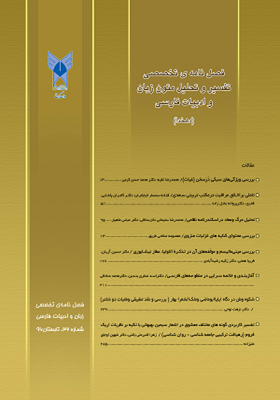آغازبندی و خاتمهسرایی در منظومههای فارسی
محورهای موضوعی : متون زبان و ادبیات فارسیاسد صفری بندپی 1 , محمد صادقی 2
1 - عضو هیات علمی دانشگاه آزاد اسلامی واحد تنکابن ،ایران
2 - عضو هیات علمی دانشگاه آزاد اسلامی واحد قائم شهر،ایران.
کلید واژه:
چکیده مقاله :
آغازبندی آثار ادبی در نثر و نظم از آغاز ادب فارسی دری معمول گردید.در آثار برجسته نثر فارسی اصطلاح (دیباچهنگاری) و در آثار برجسته منظوم اصطلاح (آغازبندی) مترادف یکدیگرند با این تفاوت که در منظومهها زمینه گستردهتری برای آغازبندی وجود دارد و چنین است در خاتمهنگاری و خاتمهسرایی.هنر آغازبندی و خاتمهسرایی را میتوان در ردیف فنون ادبی و بدیعی به شمار آورد. این آرایه بر ادب و بلاغت گفتار بزرگان ادب چه در نثر و چه در نظم میافزاید. مشرب فکری، فلسفی، مذهبی و جهانبینی سخنوران را میتوان از آغازبندیهای آنان در آثارشان دریافت و به اسرار درون آنان پی برد. این مقاله به واکاوی آغازبندی و خاتمهسرایی منظومه و مثنویهای برجستهی گلستان ادب فارسی میپردازد.آغازبندی در منظومه های فارسی با شاهنامه فردوسی شروع می شود و سپس سنایی در حدیقه الحقیقه به طور گسترده تری به آن می پردازد پس از سنایی پیروان مکتب سنایی چه در عرفان و چه در منظومه های غنایی همگی آغازبندی و خاتمه سرایی را تا دوره ی قاجاریه رعایت کرده اند. به ندرت منظومه و مثتوی می توان یافت که مانند مثنوی مولانا بدون آغازبندی و خاتمه سرایی باشد.
Since the early Dari Persian literature emerged writing a preliminary part for a literary work in prose or verse became popular. The terms “preface” (dibache negari) and “prelude” (aghaz bandi) have been used synonymously and respectively in outstanding works of Persian prose and verse, though in verse works writing a prelude has been more common than in prose works. It is also true about writing a finale or “epilogue” for an epopee. The art of composing a prelude and epilogue could be counted in the literary and rhetorical techniques row. This is in a way a literary device that adds to the eloquence and decorum of the works of literati, both in verse and prose. Intellectual, philosophical, religious and ideological points of view of the literary composers can be traced in their introductions to their works, and so can lead to discover the secrets of their thoughts. This study deals with the analysis of initiation and termination of poems and versifications in Persian literature masterpieces. Ferdowsi’s Shahnameh is the first work to include a prelude, and then Sanāʾi applies it in a broader sense in his Hadiqat al-Haqiqat, so that the followers of Sanāʾi’s literary style continue his convention of writing preludes and epilogues in their mystic or lyric poems through the reign of Qajars. Nevertheless, there are some rare works with no prelude or epilogue, the most noteworthy of which is Rumi’s Mathnavi.
_||_

